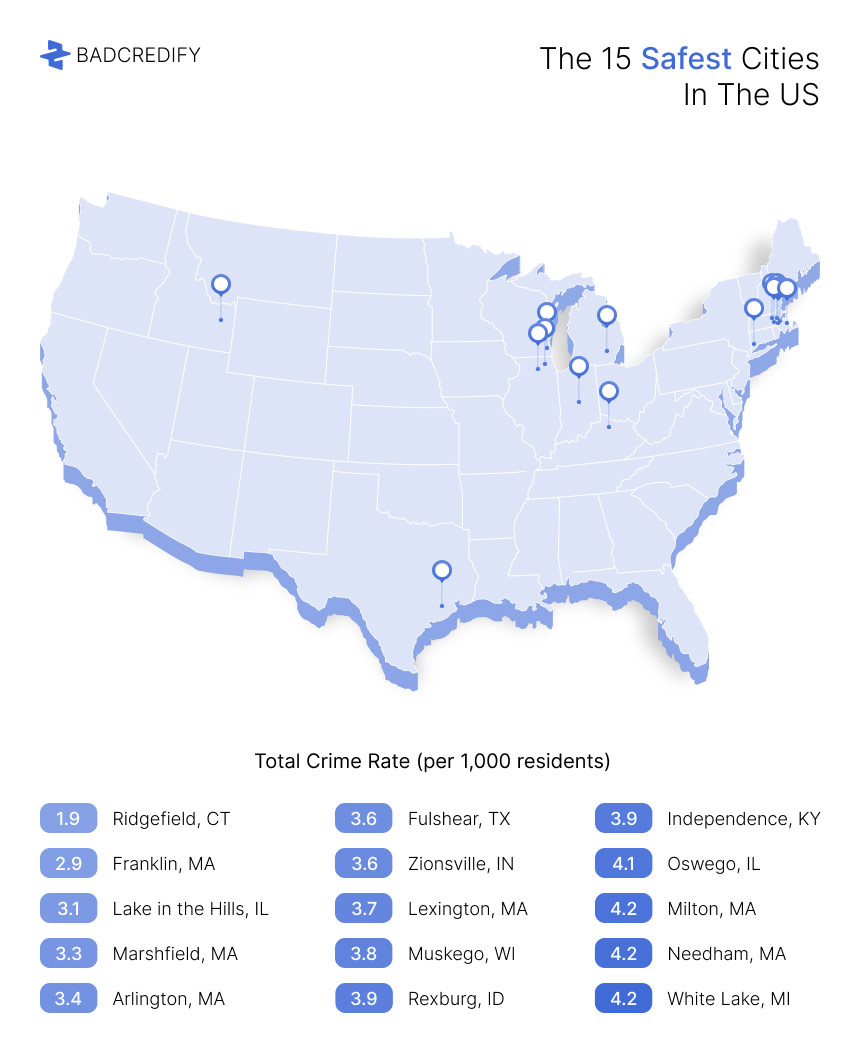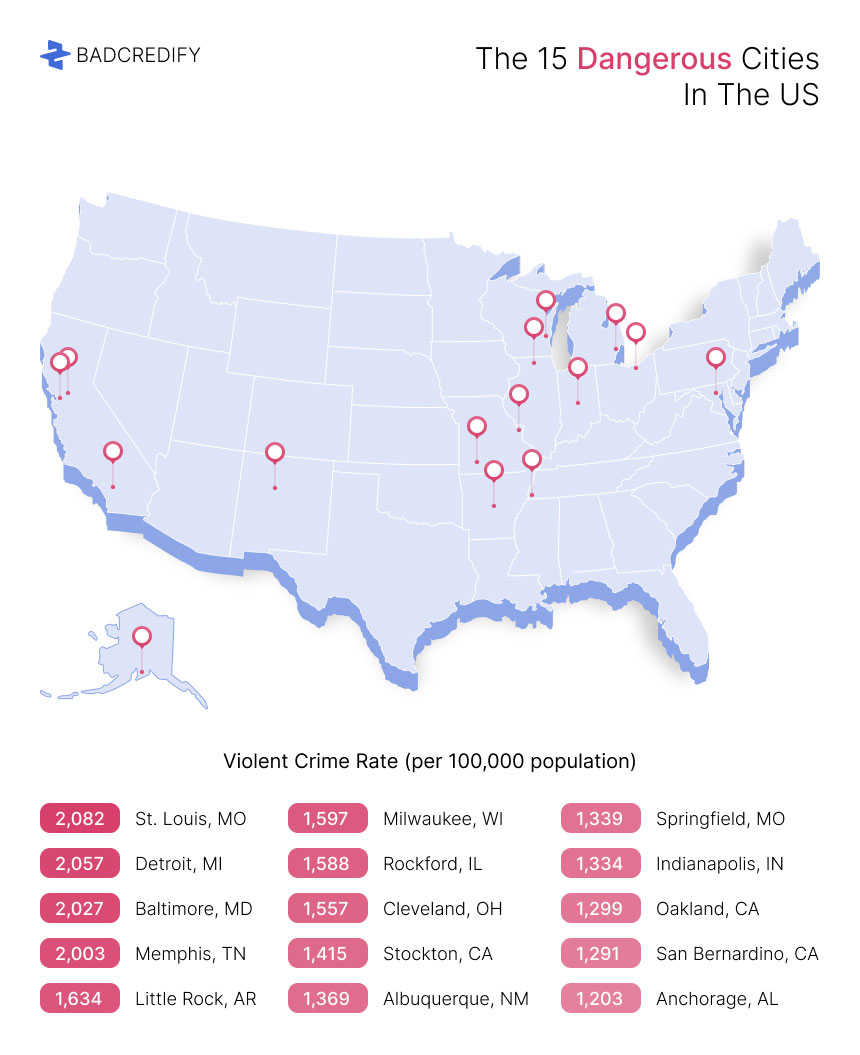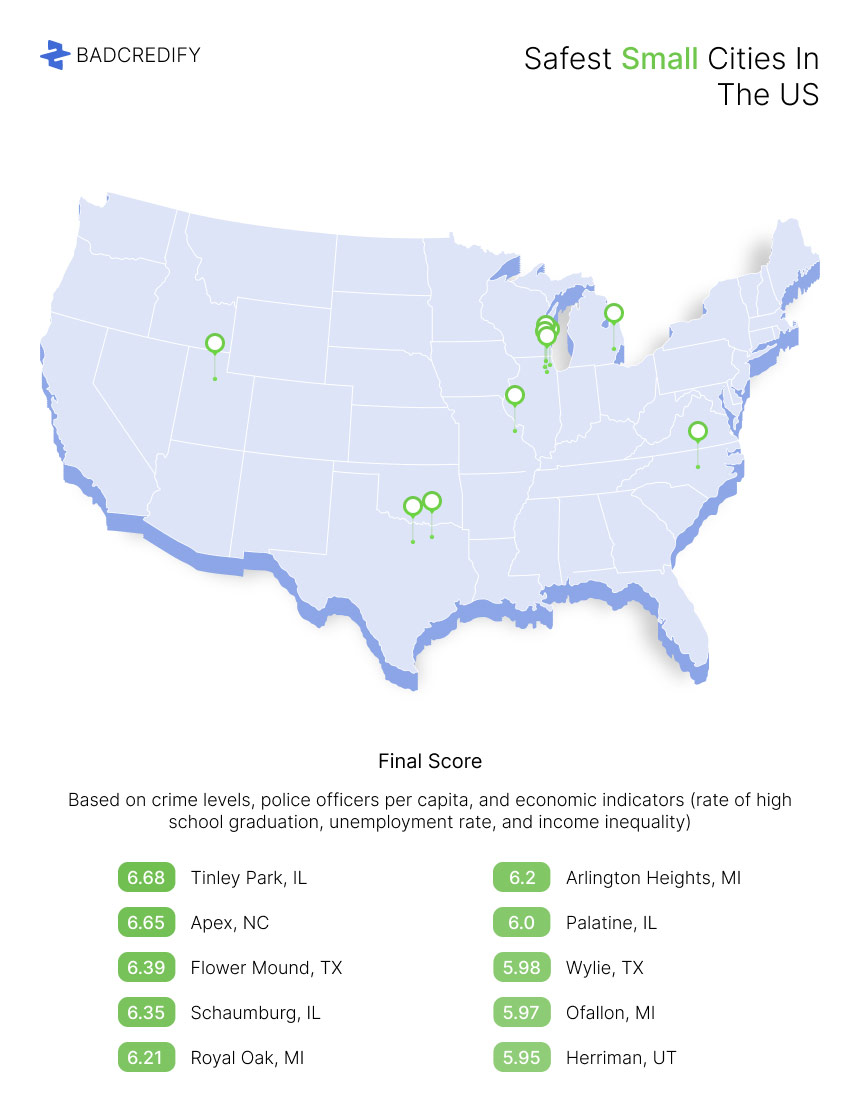When it comes to the United States, the concept of “safety” can vary widely depending on the factors you take into consideration. While idyllic small towns may demonstrate low crime rates, large cities offer vibrant opportunities but often come with a higher risk of becoming a victim of crime. Let’s find out which communities foster the most secure environments for their residents.
Key takeaways:
- Determining the safest city depends on what parameter is taken into account;
- Ridgefield, Connecticut, is the safest US city by the total crime rate, while St. Louis, Missouri, is the most dangerous one;
- Thousand Oaks, California, is the US city with the lowest cost of crime per capita as for 2024;
- Big cities with a population of 250,000 and over dominate in the number of crimes.
The 15 Safest Cities in the US

Determining the “safest” city can be subjective. This is because the results may vary depending on the type of crime you take into consideration. The safety can be assessed based on violent crimes, property crimes, murder, rape, robbery, motor vehicle theft, and much more.
To make the evaluation unbiased, it is customary to use a total crime rate. This parameter is calculated by dividing the total number of reported crimes committed in a particular area by the total population and multiplying the result by 100,000. Looking at the crime rate offers an approximate understanding of the likelihood of becoming a victim of crime in a particular town or city. Here are the 15 safest US cities based on this metric, according to the Federal Bureau of Investigation’s latest report and crime statistics by state:
| City | State | Total Crime Rate (per 1,000 residents) |
|---|---|---|
| Ridgefield | Connecticut | 1.9 |
| Franklin | Massachusetts | 2.9 |
| Lake in the Hills | Illinois | 3.1 |
| Marshfield | Massachusetts | 3.3 |
| Arlington | Massachusetts | 3.4 |
| Fulshear | Texas | 3.6 |
| Zionsville | Indiana | 3.6 |
| Lexington | Massachusetts | 3.7 |
| Muskego | Wisconsin | 3.8 |
| Rexburg | Idaho | 3.9 |
| Independence | Kentucky | 3.9 |
| Oswego | Illinois | 4.1 |
| Milton | Massachusetts | 4.2 |
| Needham | Massachusetts | 4.2 |
| White Lake | Michigan | 4.2 |
Several trends emerge from this overview. Massachusetts dominates in the list with 6 out of 15 safest cities, and they are mainly clustered around Boston. This suggests a focus on crime prevention and community engagement in these areas. Smaller cities tend to fare better, potentially due to closer community bonds and proactive police presence. However, some large cities, such as Arlington and Lexington, also demonstrate high security levels. Thus, urban environments can foster safety through dedicated initiatives.
The 15 Most Dangerous Cities in America

According to the data of World Population Review, St. Louis, MO, is the most dangerous city in the US, with a crime rate of 2,082 per 100,000 population. Here’s the full list:
| City | State | Violent Crime Rate (per 100,000 population) |
|---|---|---|
| St. Louis | Missouri | 2,082 |
| Detroit | Michigan | 2,057 |
| Baltimore | Maryland | 2,027 |
| Memphis | Tennessee | 2,003 |
| Little Rock | Arkansas | 1,634 |
| Milwaukee | Wisconsin | 1,597 |
| Rockford | Illinois | 1,588 |
| Cleveland | Ohio | 1,557 |
| Stockton | California | 1,415 |
| Albuquerque | New Mexico | 1,369 |
| Springfield | Missouri | 1,339 |
| Indianapolis | Indiana | 1,334 |
| Oakland | California | 1,299 |
| San Bernardino | California | 1,291 |
| Anchorage | Alaska | 1,203 |
Certain patterns emerge on this side of the spectrum as well. Cities with poor housing conditions, larger families with small incomes, limited economic opportunities, and high inequality tend to have higher crime rates.
Factors like inadequate access to education, healthcare, and mental health resources also correlate with a high crime rate. Additionally, a large number of homes with parents who have previously violated the law contribute to a cycle of crime. Notably, most cities on this list are located in the Midwestern and Western regions.
Safest Small Cities in The US

Another study made by Consumer Affairs determined the safest small cities with a population of 50,000 to 100,000. It took into account crime levels, police officers per capita, and economic indicators, such as rate of high school graduation, unemployment rate, and income inequality. Then, they calculated the final score based on them. Here’s the list:
| City | State | Final Score |
|---|---|---|
| Tinley Park | Illinois | 6.68 |
| Apex | North Carolina | 6.65 |
| Flower Mound | Texas | 6.39 |
| Schaumburg | Illinois | 6.35 |
| Royal Oak | Michigan | 6.21 |
| Arlington Heights | Illinois | 6.2 |
| Palatine | Illinois | 6.0 |
| Wylie | Texas | 5.98 |
| Ofallon | Missouri | 5.97 |
| Herriman | Utah | 5.95 |
Does the Size of a City Affect Its Security Level?
Comparing the two lists reveals an interesting dynamic: smaller cities often dominate the “safe” list, while larger cities tend to have more representation on the “dangerous” side.
According to the FBI Quarterly Uniform Crime Report data release for the third quarter of 2023, cities with population from 250,000 to 499,999, from 500,000 to 999,999, and 1,000,000 and over dominate in the number of crimes. Large cities also come with a higher cost of crime per capita. All these point that there’s a direct correlation between population size and crime rates.
Smaller cities are safer due to closer-knit communities, stronger interpersonal connections, and a more proactive and visible police presence. Moreover, a smaller population allows for an easier sharing of resources, thereby leading to better infrastructure and social amenities. Small towns are not averse to crime either. Offense may thrive due to isolation from major resources and depending on one industry.
When compared to rural areas, big cities are more complicated. Despite the fact that they offer many opportunities, they also have increased population densities, greater income disparities, and intricate social, as well as economic issues. These factors elevate crime rates, such as violent crimes and property crimes. Nevertheless, quite a number of large cities have had successful crime prevention programs and community outreach schemes that have obviously increased safety levels in their areas.
Consequently, this means that there is no clear-cut relationship between the size of a city and its safety. Proactive initiatives and strong leadership can make big cities safe just as much as the inherent benefits that come with small urban centers. This is to say that city planning, resource allocation, and community involvement play a bigger part in determining how safe a city is than simply its size.
How the Cost of Crime Relates to Safety
Cost of crime is a parameter used to evaluate how much a victim suffered from a crime. However, the concept goes beyond the immediate financial expenses associated with criminal activity. It encompasses the broader ripple effects of crime, including emotional distress, loss of productivity, and decreased quality of life. When a city has a high crime cost, it indicates that crime significantly impacts the well-being of its residents and businesses.Based on the FBI crime reports and Kathryn E. McCollister, Michael T. French, and Hal Fang research, financial experts made their own report and determined the safest US cities as for 2024, taking into account the cost of crime per capita:
| City | State | Crime Cost per Capita |
|---|---|---|
| Thousand Oaks | California | $241 |
| Fishers | Indiana | $296 |
| Pembroke Pines | Florida | $322 |
| Pearland | Texas | $328 |
| Gilbert | Arizona | $356 |
| Irvine | California | $364 |
| Coral Springs | Florida | $375 |
| Naperville | Illinois | $402 |
| Simi Valley | California | $404 |
| Carmel | Indiana | $405 |
| Surprise | Arizona | $418 |
| Plano | Texas | $420 |
| Elk Grove | California | $427 |
| Mckinney | Texas | $437 |
| Temecula | California | $461 |
Notably, this list differs from the rank that takes into account the crime rate. By examining crime cost, we gain a deeper understanding of the true impact of crime beyond its statistical representation. It allows us to assess the broader social and economic implications of crime and prioritize preventive measures that address the root causes of criminal activity.
How Crime Influences Communities
The consequences of crime go beyond the individual victims. Crime can destroy communities, making them lose trust and civic engagement and develop fear and hopelessness. Children who grow up in high-crime neighborhoods may have limited educational opportunities, be exposed to more violence, and feel insecure. Businesses may not want to invest in high-crime areas, which will further perpetuate economic hardship and limit job opportunities.
A city with a high violent crime rate may see residents avoiding certain areas or staying indoors out of fear. This can lead to a reduced sense of community, decreased economic activity, and a general atmosphere of anxiety. Similarly, residents of cities with a high property crime rate may face extra expenses on home security and insurance.
Crime can also worsen existing social inequalities. Communities with limited resources and support systems are often more susceptible to the negative effects of crime. Moreover, minority communities may suffer disproportionately from crime due to systemic racism and biased policing practices.
However, we can’t deal with the consequences without understanding the causes. The Effect of Education on Crime and Identifying the Effect of Unemployment on Crime studies show that states with higher levels of educational attainment also have crime rates lower than the national average. At the same time, as the unemployment rate increases, the percentage of violent crimes decreases. Thus, a person’s lack of education often increases the likelihood that they will become involved in crime behavior. Moreover, unemployment is not identified as a powerful determinant of crime.
Summing up, dealing with crime requires a complex approach that focuses not only on catching criminals but also on investing in social programs, education opportunities, and economic development initiatives. Creating strong communities that share responsibility and provide support can help create an environment where crime is less likely to thrive.
In Conclusion
City safety is a complex parameter that can vary depending on the measurement criteria and methodology used. Crime in cities may be unevenly allocated by areas or may be dominated by a particular type of crime. For the most objective assessment, we used such indicators as total crime rate, violent crime rate, and cost of crime per capita. This complex approach allows us to show the most comprehensive picture.
Since crime is a sociological phenomenon influenced by a variety of factors, crime statistics should not be used to rank locations or make comparisons to measure law enforcement effectiveness.
Methodology
BadCredify’s research analyzed data provided by official government agencies and other trusted resources, such as the FBI reports, “The Cost of Crime to Society” research, World Population Review, Safewise data, Consumer Affairs study, The Effect of Education on Crime and Identifying the Effect of Unemployment on Crime studies. We did our own comprehensive research based on the information found. A combination of such things as violent crime rates, property crime rates, and the overall crime cost per capita were used to compile the “safest” and “most dangerous” lists.
However, it is worth noting that different methodologies and data sources may lead to different rankings. Since not all agencies have reported 2023’s latest data, information can be incomplete. The intention of this article was to give an overview of how safe American cities currently are. However, we recognize that this analysis is inherently complex and nuanced.
It is essential to note that the crimes found in the Crime Data Explorer are those that have been reported and do not represent all crimes committed in an area. In order to make sense out of this information, it is important to consider various factors which contribute to the occurrence of criminal activities as well as crime reporting within a particular community.
Sources
BadCredify’s experts rely on government data, industry experts, and original research from other reputable publications. Specific sources for this article include:
- The Federal Bureau of Investigation’s Crime Data Explorer;
- The FBI Quarterly Uniform Crime Report;
- World Population Review;
- The Cost of Crime to Society: New Crime-Specific Estimates for Policy and Program Evaluation by E. McCollister, Michael T. French, and Hal Fang
- The Effect of Education on Crime: Evidence from Prison Inmates, Arrests, and Self-Reports by Lance Lochner and Enrico Moretti;
- Identifying the Effect of Unemployment on Crime by Steven Raphael and Rudolf Winter‐Ebmer.

